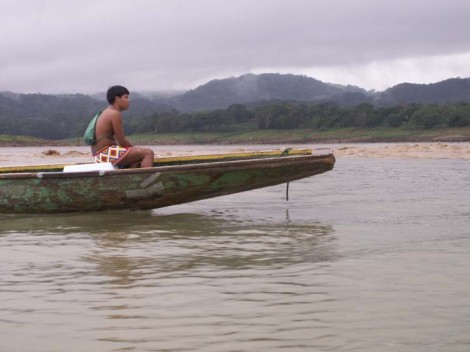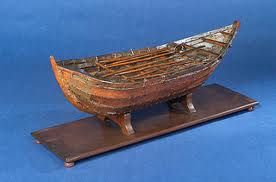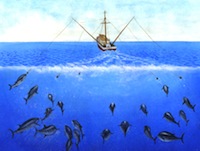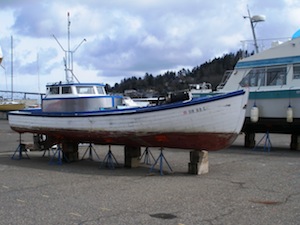
|
||||||||||||
| Fisheries :: Harvest and Post Harvest | ||||||||||||
|
Fishing Crafts Fishing crafts are most essential for catching the fish in large scale in water bodies. A large variety of crafts (boats) have been designed for marine and inland fishing in India. The types of fishing crafts of India falls under two general categories. These are non-mechanized and mechanized fishing crafts. Non-mechanised boats (i) Catamaran: The simplest type of fishing craft may be taken as the one formed by a few curved logs of wood joined together forming a kind of floating raft, such as the ones used along the east coast of India. Four types of catamarans are prevalent in Indian waters, namely the Orissa type, Andhra type, Coromandal type and Kanyakumari type. (ii) Dug-out canoes: A simple type of fishing craft for fishing within short distances from the coast is a small-sized canoe made by scooping logs of wood in the form of boat. The “Odams”, “Thonies”, “Vanchies” etc. of the southeast and south-west coasts of India come under this category. In calm weather, oars may be enough for propulsion; but if winds and currents prevail, sails may be used. (iii) Plank-built canoes: This is an enlarged variety of dug-out canoe made of planks on the sides, largely used in Kerala. (iv) Masula boats: It is made of non-rigid planks sewn together with coir ropes and are common along Andhra coast. (v) Dhinghi: This is a carvel type of boat designed and constructed for a variety of purposes including fishing. (vi) Outrigger canoes: Some times plank-built canoes may be provided with a single outrigger as in the “rampani” boats used for capturing mackerel in Karnataka. (vii) Built-up boats: In most of the boats made at present, the carvel type of boats is built up of planks. The best type of built-up boats is seen in centres along the northeast coast of India.
Mechanized boats With the advent of mechanization of the fishing crafts, small and medium sized boats, 10 to 15 m long, are constructed with engines operated by oil for venturing to distant coastal areas in search of fishing grounds. The machanised crafts are line boats, trap boats, dolnetter, gillnetter, trawlers. (i) Hand line boat: Hand line boats can be operated both in the shallow and deeper waters. The traditional hand liners use no winch. In India the gear usually consists of a few meters of monofilament of 0.5 mm to 1 mm diameter to the end of which is attached a hood and a sinker, usually a small stone. They are used to catch all kinds of demersal fish from motorized as well as small-mechanised vessels. (ii) Pole and line fishing vessel: Pole and line fishing vessels are fitted with a narrow platform protruding all round the vessel at deck level, outside the bulwarks. The platform extends forward from the stern to the fore-end like a bowsprit. The crew stands on the platform with their backs to the riel when fishing with the poles. The most popular craft for pole and line fishing in India is ‘mas odi’ of Minicoy. It is a wooden craft 12.5m long and 3m wide at the stern, made from venteak, coconut or aini wood. The back end is provided with a broad raised fishing platform. The propulsion of the craft is by sail or by oars. Nearly 20 to 25 men work on each craft. (iii) Trolling vessel: Trolling line boats tow lines extending on either side to catch pelagic species having high individual value and good quality, such as tuna and baracuda. A number of lures hanging from outrigger poles through lines are towed from a slowly moving vessel. The fish hooked after snapping at the lure are brought on board as the line is hauled in. The lures after detaching the fish are put again into the water. The vessel lengths vary between 25’ - 50’ and have normally a forward wheelhouse arrangement allowing a clear working deck aft. (v) Gill netter: Vessels of almost any size can undertake gill netting. The number of nets used for fishing is adjusted to suit the size of the operating vessel. The vessels vary in length between 25’ and 55’. The deck must be so laid out that the gear can be conveniently stowed, with a clear passage from bow to stern so that the gear can be passed after hauling. An arrangement with wheelhouse and engine room forward or behind may be used depending on the operating method adopted. In a typical arrangement with the engine and wheelhouse in the backward configuration, sufficient deck space must be available behind the house for storing and handling the net. A forward arrangement can also be used for side hauling, in which case the wheelhouse is sometimes so located to provide a clear working passage. (xiii) Stern trawlers: Fishing over the stern can be a very efficient way of trawling. Stern trawling is the most wide-spread method of fishing in India. The vessels range in size from 32’ to 55’ in length and may be fitted with 60 to 120 horsepower engine and above. Vessels above 45’ in length may also be constructed in steel. The most common deck layout is such that the wheelhouse is just forward of amidships with working deck behind. The winch powered by the engine is located behind the wheelhouse with the warps leading to the gallows located at the middle or sides of the stern, from which the otter boards hang.
(Source: www.vuatkerala.org) Updated on Feb 2015 |
||||||||||||
© All Rights Reserved. TNAU 2009-15. |
||||||||||||







